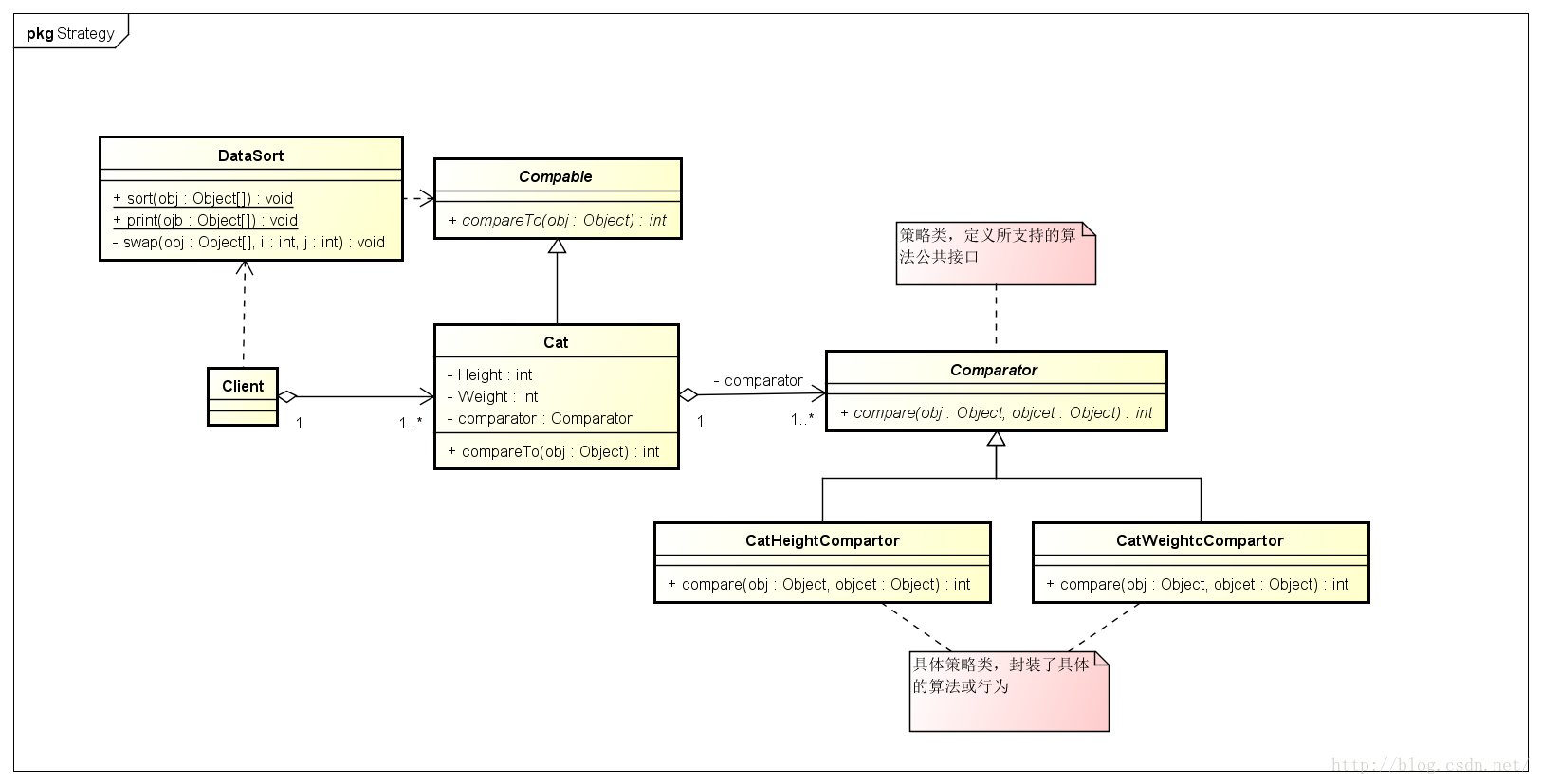策略模式:(strategy)定义算法家族,分别封装起来,让他们之间可以相互替换。此模式可以让算法的变化,不影响使用算法的用户。
详细介绍:https://blog.youkuaiyun.com/smartboy_01/article/details/42271885
使用策略模式构建的通用排序步骤
- 定义DataSort排序类
public class DataSorter {
/**
* 冒泡排序方法
* @param a
*/
public static Object sort(Object[] a) {
for(int i = a.length; i > 0; i--) {
for(int j = 0; j < i-1; j++) {
Comparable o1 = (Comparable)a[j];
Comparable o2 = (Comparable)a[j+1];
if(o1.compareTo(o2) == 1) {
swap(a, j , j+1);
}
}
}
return a;
}
/**
* 交换
* @param a
* @param x
* @param y
*/
private static void swap(Object[] a, int x, int y) {
Object temp = a[x];
a[x] = a[y];
a[y] = temp;
}
/**
* 输出排序结果
* @param objects
*/
public static void printSortResult(Object[] objects){
for (Object object : objects) {
System.out.print(object + " ");
}
System.out.println();
}
}
- 定义
Comparable接口,包含int compareTo(Object obj)方法,正如Java JDK自带的Comparable类,所有要排序的类,都实现此接口,实现各自的compareTo()方法,这样就DataSort类就可以实现了复用。(此时并未使用到策略模式)
public interface Comparable {
/**
* 比较方法
* @param o
* @return
*/
int compareTo(Object o);
}
- 创建要排序的类,实现
Comparable接口,实现compareTo()方法,此时每次排序条件改变都要修改compareTo()方法中的排序条件,比较繁琐,不利于拓展。
public class Tiger implements Comparable {
//老虎重量
private int weight;
public int getWeight() {
return weight;
}
public void setWeight(int weight) {
this.weight = weight;
}
public Tiger(int weight) {
this.weight = weight;
}
/**
* 自定义排序方法
*/
@Override
public int compareTo(Object o) {
int rs = 0;
Tiger tiger = (Tiger) o;
if(this.weight > tiger.getWeight()){
rs = 1;
}else if(this.weight < tiger.getWeight()){
rs = -1;
}else{
rs = 0;
}
return rs;
}
@Override
public String toString() {
return this.weight + "";
}
}
但是,有时我们有很多的排序规则,事先并不确定,这是修改compareTo()方法将是一个很不明智的选择。这时,可以抽象出公共算法接口,如:Comparator,而它的子类实现具体的排序规则,当需要更多的排序规则时,仅仅需要创建新的类实现Comparator就可以。这样就使我们的程序拥有更好的可扩展性。
- 抽象出公共算法接口
Comparator
/**
* 抽象出来比较方法
* 使用策略模式
*/
@SuppressWarnings("ALL")
public interface Comparator {
int compare(Object o1, Object o2);
}
- 创建需要排序的类,实现
Comparable接口
public class Dog implements Comparable{
private int height;
private int weight;
//设置不同的比较类,进行不同条件比较
private Comparator comparator = new DogHeightComparator();
public Dog(int height, int weight) {
this.height = height;
this.weight = weight;
}
public int getHeight() {
return height;
}
public void setHeight(int height) {
this.height = height;
}
public int getWeight() {
return weight;
}
public void setWeight(int weight) {
this.weight = weight;
}
public Comparator getComparator() {
return comparator;
}
public void setComparator(Comparator comparator) {
this.comparator = comparator;
}
public String toString() {
return height + "|" + weight;
}
@Override
public int compareTo(Object o) {
return comparator.compare(this,o);
}
}
- 创建具有具体的排序规则比较器类
/**
* 高度比较器
*/
@SuppressWarnings("ALL")
public class DogHeightComparator implements Comparator{
@Override
public int compare(Object o1, Object o2) {
Dog dog1 = (Dog) o1;
Dog dog2 = (Dog) o2;
int rs = 0;
if(dog1.getHeight() > dog2.getHeight()){
rs = 1;
}else if(dog1.getHeight() < dog2.getHeight()){
rs = -1;
}else {
rs = 0;
}
return rs;
}
}
/**
* 重量比较器
*/
public class DogWeightComparator implements Comparator {
@Override
public int compare(Object o1, Object o2) {
Dog dog1 = (Dog) o1;
Dog dog2 = (Dog) o2;
int rs = 0;
if(dog1.getWeight() > dog2.getWeight()){
rs = 1;
}else if(dog1.getWeight() < dog2.getWeight()){
rs = -1;
}else {
rs = 0;
}
return rs;
}
}
Comparator的子类实现具体的排序规则,当需要更多的排序规则时,仅仅需要创建新的类实现Comparator就可以。这样就使我们的程序拥有更好的可扩展性。
类图如下:








 本文介绍了策略模式,即定义算法家族并封装,使其可相互替换,不影响用户。详细说明了使用策略模式构建通用排序的步骤,包括定义排序类、接口,创建排序类实现接口等。还指出抽象公共算法接口可让程序在面对多种排序规则时更具扩展性。
本文介绍了策略模式,即定义算法家族并封装,使其可相互替换,不影响用户。详细说明了使用策略模式构建通用排序的步骤,包括定义排序类、接口,创建排序类实现接口等。还指出抽象公共算法接口可让程序在面对多种排序规则时更具扩展性。
















 1292
1292

 被折叠的 条评论
为什么被折叠?
被折叠的 条评论
为什么被折叠?








